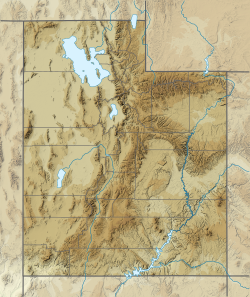Bluff Formation
| Bluff Formation | |
|---|---|
| Stratigraphic range: | |
 Bluff Formation at its type area, Bluff, Utah, US | |
| Type | Formation |
| Unit of | San Rafael Group |
| Underlies | Morrison Formation |
| Overlies | Summerville Formation |
| Thickness | 350 ft (110 m) |
| Lithology | |
| Primary | Sandstone |
| Other | Mudstone |
| Location | |
| Coordinates | 37°17′21″N 109°33′06″W / 37.2893°N 109.5518°W |
| Region | Four Corners |
| Country | |
| Type section | |
| Named for | Bluff, Utah |
| Named by | Baker, Dane, and Reeside |
| Year defined | 1936 |
The Bluff Formation is a geological formation found in the Four Corners area. It was deposited in the late Jurassic Period.
Description
The Bluff Formation consists of massive wind-deposited (eolian) sandstone beds at its type location at Bluff, Utah. These cap the cliffs north of town and are 100–350 feet (30–107 m) thick.[1] Further to the southeast, the sandstone beds lack high-angle cross beds, being dominated instead by horizontal bed forms, and are overlain by mixed sandstone and shale beds of the Recapture Member. The Recapture Member has been variously assigned either to the overlying Morrison Formation[1] or to the Bluff Formation.[2][3] The Recapture Member is separated from the Salt Wash Member of the Morrison Formation by the regional J-5 unconformity.[4]
History of investigation
The formation was first named as the Bluff Sandstone by A.A. Baker, C.H. Dane, and J.B. Reeside, Jr., in 1938. They assigned it to the lower Morrison Formation.[5][1] J.W. Harshbarger, Charles Repenning, and J.H. Irwin promoted it to formation rank in 1957,[6] but this was not universally accepted.[7][8] Spencer G. Lucas advocated both for formation rank and for assigning the Recapture Member to the Bluff Sandstone.[3] Steven M. Cather agreed with promotion of the Bluff Sandstone to formation rank but advocated leaving the Recapture Member with the Morrison Formation.[9]
References
- ^ a b c Gregory, H.E. (1938). "The San Juan country, a geographic and geologic reconnaissance of southeastern Utah". U.S. Geological Survey Professional Paper. 188. doi:10.3133/pp188. hdl:2027/mdp.39015011731844.
- ^ Anderson, Orin J.; Lucas, Spencer G. (August 1995). "Base of the Morrison Formation, Jurassic, of northwestern New Mexico and adjacent areas" (PDF). New Mexico Geology: 44–53. Retrieved 31 October 2020.
- ^ a b Lucas, Spencer G. (2020). "Jurassic stratigraphy of the southeastern Colorado Plateau, west-central New Mexico: 2020 synthesis" (PDF). New Mexico Geological Society Special Publication. 14: 135–144. Retrieved 30 October 2020.
- ^ Lucas, Spencer G. (2014). "Lithostratigraphy of the Jurassic San Rafael Group from Bluff to the Abajo Mountains, southeastern Utah: Stratigraphic relationships of the Bluff Sandstone". Volumina Jurassica. 12 (2): 55–68. doi:10.5604/17313708.1130128. Retrieved 31 October 2020.
- ^ Baker, A.A.; Dane, C.H.; Reeside, J.B. Jr. (1936). "Correlation of the Jurassic formations of parts of Utah, Arizona, New Mexico, and Colorado". U.S. Geological Survey Professional Paper. 183. doi:10.3133/pp183.
- ^ Harshbarger, J.W.; Repenning, C.A.; Irwin, J.H. (1957). "Stratigraphy of the uppermost Triassic and the Jurassic rocks of the Navajo country". U.S. Geological Survey Professional Paper. 291. doi:10.3133/pp291.
- ^ O'Sullivan, Robert (1980). "Stratigraphic sections of Middle Jurassic San Rafael group from Wilson Arch to Bluff in southeastern Utah". U.S. Geological Survey Oil and Gas Investigations. OC-102. Retrieved 31 October 2020.
- ^ Condon, Steven M.; Huffman, A.C. Jr.; Peterson, Fred; Aubrey, W.M. (1988). "Revisions to stratigraphic nomenclature of Jurassic and Cretaceous rocks of the Colorado Plateau". U.S. Geological Survey Bulletin. 1633-A-C. doi:10.3133/b1633AC.
- ^ Cather, Steven M. (2020). "Jurassic stratigraphic nomenclature for northwestern New Mexico" (PDF). New Mexico Geological Society Special Publication. 14: 145–151. Retrieved 31 October 2020.


